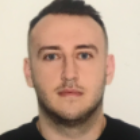
Andrii Dychka
Work place: Computer Systems Software Department, Faculty of Applied Mathematics, Igor Sikorsky Kyiv Polytechnic Institute, Kyiv, 03056, Ukraine
E-mail: andriydychka@gmail.com
Website: https://orcid.org/0000-0003-0578-2788
Research Interests: Software
Biography
Dr. Andrii Dychka obtained his Ph.D in software engineering in 2024. The research related to the dissertation was conducted at the National Technical University of Ukraine "Igor Sikorsky Kyiv Polytechnic Institute" within the framework of the state-funded scientific project titled "Mathematical and software methods for processing multimodal monitoring data of biomedical objects for the purpose of patient health status diagnostics." He is currently an assistant professor at the Computer Systems Software Department, Faculty of Applied Mathematics at the National Technical University of Ukraine “Igor Sikorsky Kyiv Polytechnic Institute”, Ukraine. Author and co-author of 12 scientific publications and 2 textbooks. His research interests include issues related to programming, application software, software architecture, medical information systems, automatic identification, multicolor barcoding, digital medicine.
Author Articles
Geodesic Curves Simulation on a Transcendental Surface with a Cycloidal Generatrix Using the Calculus of Variations
By Viktor Legeza Liubov Oleshchenko Andrii Dychka
DOI: https://doi.org/10.5815/ijisa.2025.04.02, Pub. Date: 8 Aug. 2025
This article introduces a novel variational approach for solving the inverse geodesic problem on a transcendental surface shaped as a cylindrical structure with a cycloidal generatrix, a type of geometry that has not been previously studied in this context. Unlike classical models that rely on symmetric surfaces such as spheres or spheroids, this method formulates the geodesic path as a functional minimization problem. By applying the Euler–Lagrange equation, an analytical integration of the corresponding second-order differential equation is achieved, resulting in a parametric expression that satisfies boundary conditions. The effectiveness of the proposed method for computing geodesic curves on transcendental surfaces has been rigorously evaluated through a series of numerical experiments. Analytical validation has been carried out using MathCad, while simulation and three-dimensional visualization have been implemented in Python. Numerical experiments are conducted and 3D visualizations of the geodesic lines are presented for multiple point pairs on the surface, demonstrating the accuracy and computational efficiency of the proposed solution. This enables a closed-form analytical representation of the geodesic curve, significantly reducing computational complexity compared to existing numerical-heuristic methods.
The obtained results offer clear advantages over existing studies in the field of computational geometry and variational calculus. Specifically, the proposed method enables the construction of geodesic curves on complex transcendental surfaces where traditional methods either fail or require intensive numerical approximation.
The analytical integration of geodesic equations enhances both accuracy and performance, achieving an average computational cost reduction of approximately 27-30% and accuracy improvement of around 20% in comparison with previous models utilizing non-polynomial metrics. These enhancements are especially relevant in applications requiring real-time response and precision, such as robotics, CAD systems, computer graphics, and virtual environment simulation. The method’s ability to deliver compact and exact solutions for boundary value problems positions it as a valuable contribution for both theoretical and applied sciences.
Computed Tomography Image Segmentation Technology Based on ResNet Network Integrated into the Probabilistic Model
By Zhengbing Hu Kostiantyn Zvieriev Oksana Shkurat Andrii Dychka
DOI: https://doi.org/10.5815/ijigsp.2025.04.02, Pub. Date: 8 Aug. 2025
Medical image segmentation is a significant and complex challenge in medical imaging. In recent years, deep learning models have been applied to image segmentation and have shown exceptional performance. However, medical image segmentation has a scarcity of expert-labeled data compared to other deep learning research fields. Therefore, augmenting medical expert-labeled data are primarily the easiest and fastest way to improve the deep learning model’s performance. In this paper, computed tomography image segmentation technology based on the ResNet network integrated into the probabilistic model has been proposed. The proposed segmentation technology is based on the deep learning model of the ResNet50 architecture to extract features from images and initially detect objects of interest and on the probabilistic model with weighted parameters that employs conditional random fields, the GrabCut algorithm, and the argmax function to perform the final detection of objects of interest.
To train, test, and evaluate the effectiveness of the proposed method, appropriate chest CT datasets were identified to solve the task of segmenting the lung cavity, the liver and areas affected by COVID-19. The proposed image segmentation technology demonstrates segmentation accuracy results of 73.12% by Dice Score for the COVID-19 disease dataset, 97.71% for the lung cavity dataset, and 98.36% for the liver dataset, which perform better than state-of-the-art solutions.
The proposed image segmentation technology has been compared with state-of-the-art technologies (SegNet, UNet, and FCN-ResNet50) for CT segmentation to demonstrate the effectiveness of the method. The positive outcomes strongly suggest the significant potential of the proposed image segmentation technology. According to the obtained results, the proposed image segmentation technology can be a useful auxiliary tool for doctors to segment CT images for further analysis and monitoring of statistical and dynamic indicators.
Other Articles
Subscribe to receive issue release notifications and newsletters from MECS Press journals